At times, we all yearn for a deeper connection. This connection can be with others or within ourselves. I recall a morning in my garden, where the soft light made me want to connect my body with something more.
This desire led me to Chinese Scholar’s Calisthenics. It combines physical activity with mental focus and philosophy. Rooted in Chinese traditions, these practices offer a path to balance and harmony in our fast-paced lives. Exploring these ancient techniques, I found their benefits are still powerful today.
Let’s journey together to discover Chinese Scholar’s Calisthenics. It’s a mix of movement, meditation, and philosophy that can boost our wellness. By connecting with the past, we can change our present and future health. This is a chance to explore historical mind-body fitness for today’s wellness.
Understanding the Roots of Chinese Scholar’s Calisthenics
Chinese Scholar’s Calisthenics has deep roots in ancient China’s culture and medicine. These exercises were more than just workouts. They were about living a balanced life.
The Philosophical Foundations
Daoism and Confucianism are at the heart of this practice. They teach us to find harmony within ourselves and the world. Practitioners aim to flow like water, using movements to connect their mind and body.
Historical Context in Traditional Chinese Medicine
Traditional Chinese medicine sees health as a balance of movement, breath, and focus. The Yijinjing shows how ancient people believed in aligning body energies with nature. This approach strengthens the body, clears the mind, and uplifts the spirit.
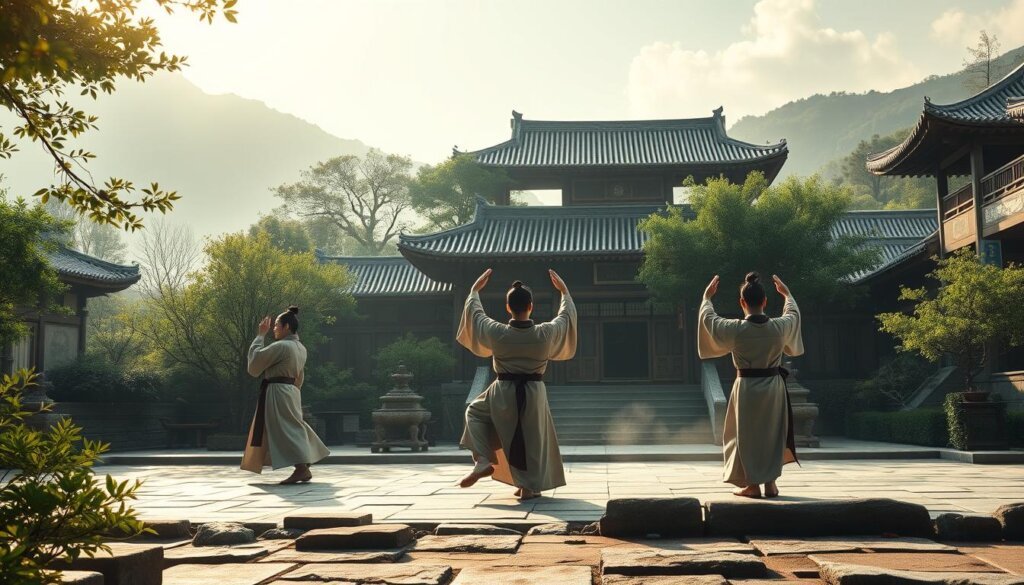
Exploring this practice, I see its lasting impact on today’s health routines. It connects us to a rich legacy of balance and harmony.
The Connection of Mind and Body in Ancient Practices
Ancient practices of calisthenics show a deep link between mind and body. They take a holistic view that still matters today. This connection highlights the role of Qi, our vital energy, which affects both physical and emotional health.
The Role of Qi in Mind-Body Harmony
Qi is key to mind-body harmony. It helps us become aware of this life force. Through exercise, I’ve learned to move with my breath, improving Qi flow.
This awareness has boosted my physical strength and emotional balance. It makes my fitness journey more rewarding.
Yang-Yin Philosophy as a Guiding Principle
Exploring Yang-Yin philosophy sheds light on this practice. It teaches that opposites work together and support each other. This is seen in calisthenics’ movements and mindfulness.
This philosophy shows that true wellness is a mix of energy and calm. It stresses the need for mind-body harmony in our ever-changing lives.

Benefits of Chinese Scholar’s Calisthenics: Historical Mind-Body Fitness for Modern Wellness
Chinese scholar’s calisthenics offers many benefits beyond regular workouts. It connects the mind and body, which is great for today’s wellness.
Improving Physical Health
Chinese scholar’s calisthenics is great for physical health. It boosts circulation and muscle tone. The movements also improve flexibility and balance.
Studies show it helps older adults stay healthy. It’s a smart choice for a healthy life as we age.
Enhancing Mental Clarity and Emotional Wellness
These exercises are good for the mind too. They help clear your mind and reduce stress. Focusing on breath and movement improves emotional stability.
They offer a meditative experience. This is perfect for today’s wellness needs.
Boosting Flexibility and Balance
The movements in Chinese scholar’s calisthenics improve flexibility and balance. Regular practice enhances coordination and stability. It’s especially good for older adults.
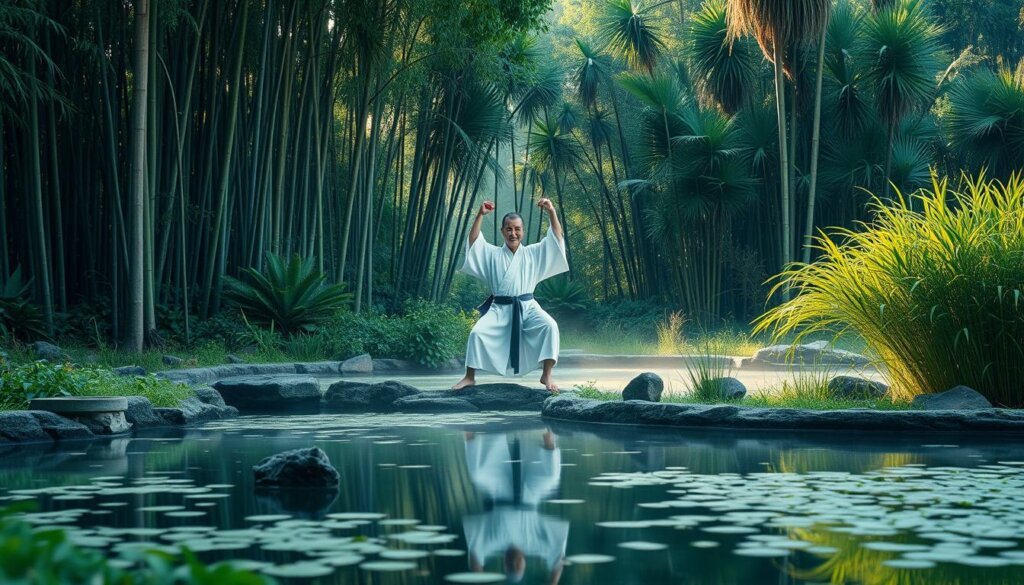
Integrating Traditional Chinese Calisthenics into Modern Routines
Adding Chinese Scholar’s Calisthenics to my daily routine is both enriching and refreshing. These exercises, with their deep historical roots, boost my wellness. I can fit them into my day in short, manageable sessions.
Daily Practices for Wellness
Starting my day with daily practices for wellness using Chinese calisthenics changes me. Simple morning stretches or breathing exercises set a positive tone. These activities improve my flexibility and strength and help my emotional balance.
Regularly doing these exercises makes me more mindful and well. It positively affects my daily life.
Blending with Contemporary Fitness Techniques
Mixing old and new in fitness opens up exciting possibilities. By blending traditional calisthenics with contemporary fitness techniques like yoga and Pilates, I get stronger and more connected to my body. This mix lets me try different movement styles, making my workouts more interesting.
This approach to fitness combines ancient wisdom with modern needs. It creates a complete fitness experience.
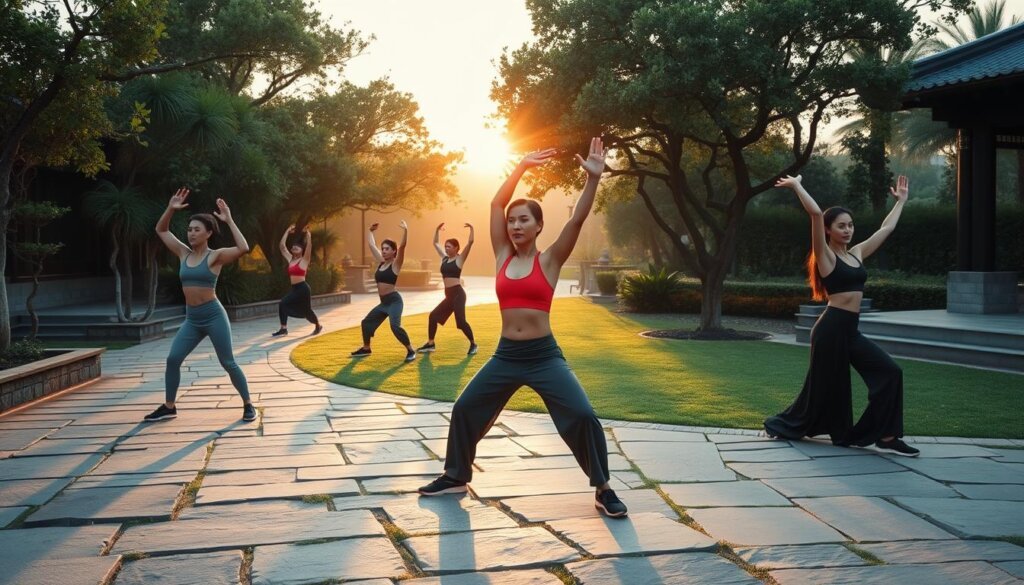
Key Exercises in Chinese Scholar’s Calisthenics
Chinese Scholar’s Calisthenics combines various exercises to improve both mind and body. It uses special breathing techniques to help find calm and stay healthy. These practices help me connect with myself and notice my surroundings more.
Breathing Techniques: Calming the Mind
The breathing methods I use are more than just for relaxing. They help calm my mind and build resilience against stress. By focusing on my breath, my lung capacity and mental clarity grow. This focus is key to achieving a balanced and peaceful state.
Flowing Movements: Synchronizing Body and Spirit
The flowing movements in Chinese Scholar’s Calisthenics are beautiful and meditative. They connect my body and spirit in a special way. These slow actions bring me peace and follow the principles of holistic fitness, as seen in ancient Chinese texts.
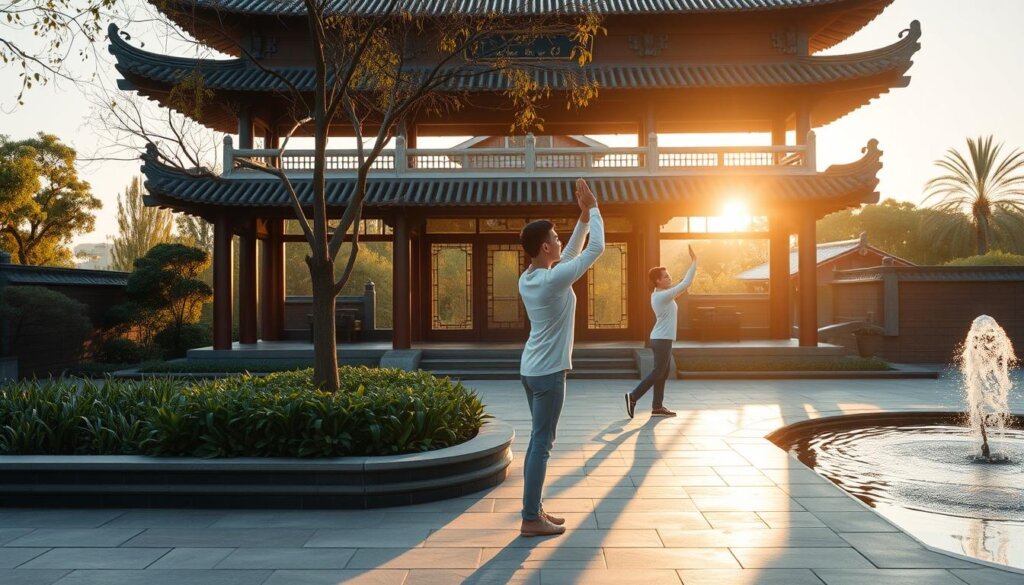
Adapting Ancient Techniques for Today’s Fitness World
Adding ancient Chinese calisthenics to my workout routine is a thoughtful process. It lets me connect with old traditions while meeting today’s health needs. This mix boosts my physical strength and mental health.
Creating a Personalized Exercise Regimen
I make a workout plan that fits my goals. First, I check my fitness level and what I want to achieve. I choose slow, mindful moves that respect the tradition.
This way, my routine is fun and works well. Each workout is tailored to me, making the most of these old fitness methods.
Utilizing Technology for Learning
Technology is key in my fitness journey. It helps me learn from experts through online classes and videos. Apps track my progress, helping me improve my routine.
This tech use not only improves my learning but also connects me with others worldwide. We share tips and support each other.
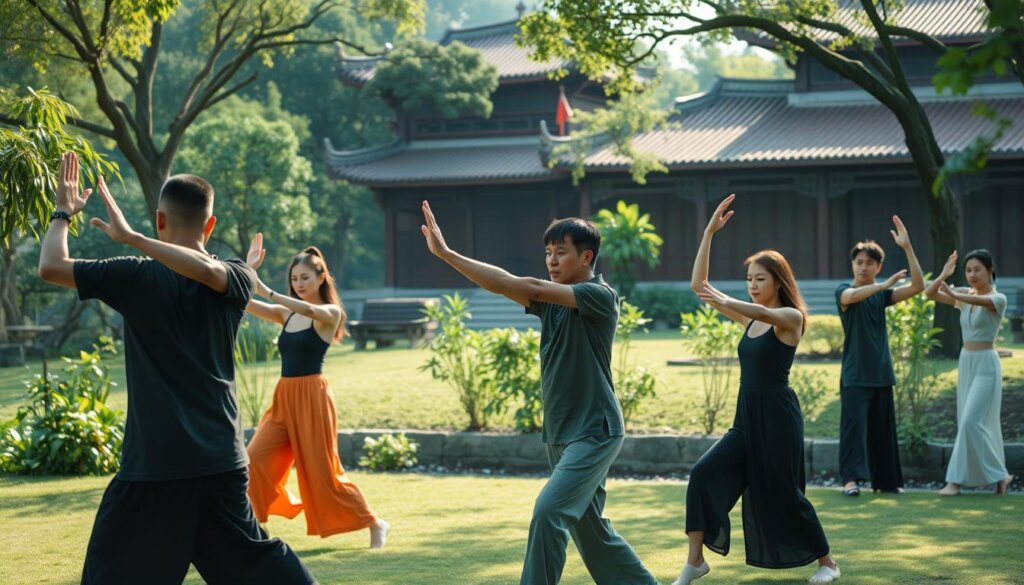
| Element | Personalized Regimen | Technology Utilization |
|---|---|---|
| Assessment | Tailored to individual goals | Access to expert guidance |
| Routine | Incorporates ancient movements | Tracks progress and adjustments |
| Community | Personal connections | Global network of enthusiasts |
Holistic Approaches to Wellness Through Chinese Traditions
Chinese Scholar’s Calisthenics shows how to improve both body and mind. It uses old practices to help us stay healthy today. These methods help our body and mind work together.
Combining Physical and Mental Health Techniques
Traditional exercises from ancient China really help my health. They’re not just about moving; they also include breathing, meditation, and being mindful. Mixing physical and mental exercises makes me feel stronger and clearer.
The way we breathe and move together is very powerful. It makes me feel better overall.
Community and Social Engagement in Practices
Going to group classes and events has made my fitness journey better. Being part of a community makes me more motivated and accountable. I learn from others and feel a shared goal.
This sense of community makes me more dedicated to staying healthy. It shows that wellness is not just about me, but also about being part of a supportive group.
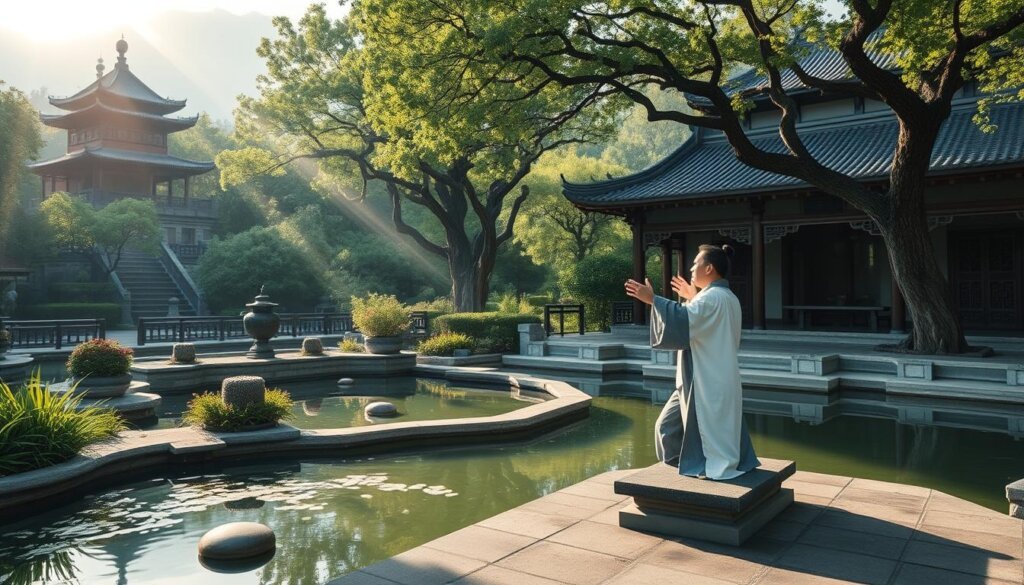
The Role of Education in Preserving Historical Wellness Practices
Education is key in keeping ancient wellness practices alive. This includes Chinese Scholar’s Calisthenics, Taijiquan, and Qigong. By teaching these traditions well, they can face today’s wellness challenges head-on. A balanced teaching approach helps us understand and value these old techniques.
Teaching Methods in Taijiquan and Qigong
Teaching Taijiquan and Qigong focuses on both the body and mind. Teachers use hands-on examples and words to create a deep learning space. Students improve their physical skills and learn about the mental and spiritual sides of their training.
Traditional classes and workshops include partner exercises. This lets students practice with each other.
Modern Institutions Promoting Ancient Practices
Today, schools and wellness centers are key in sharing these old practices. They offer courses and workshops on Taijiquan and Qigong. This shows how these practices are still valuable today.
These places help bridge the gap between old wisdom and new fitness trends. They show that these practices are still important in our lives.
Conclusion
My journey into Chinese scholar’s calisthenics has shown me the value of ancient practices for today’s wellness. These workouts blend physical and mental health, empowering me to seek overall well-being. They highlight the importance of the mind-body connection and the balance of Qi, our vital energy.
Adding historical Chinese fitness to modern routines is a game-changer. I’ve seen how Tai Chi boosts my physical and mental health. It improves bone density and boosts self-confidence, showing the lasting value of ancient wisdom.
Studies have identified nine key areas where these calisthenics help. They improve fitness and quality of life. By embracing these ancient practices, I’ve gained physical strength and mental clarity. This enriches my path to well-being.

